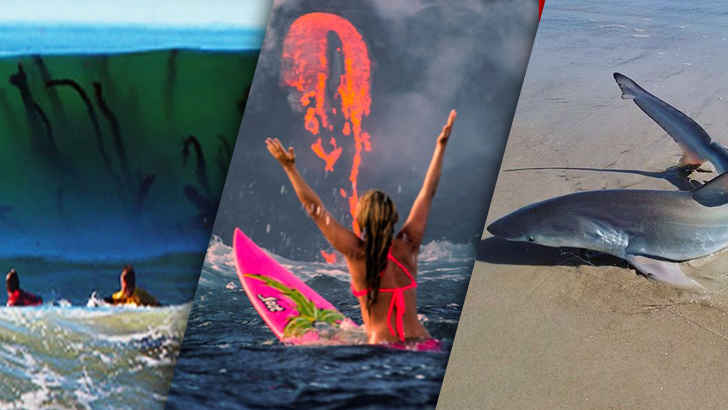TRENDING
The World’s Most Dangerous Beaches
Published
5 years agoon
Whether it’s just a day trip to get your mind off work or a full-blown vacation, there are few better ways in the world to relax. However, no two beaches are the same, and some are a lot better suited for the job than others.

It turns out that visiting the coast comes with its fair share of dangers. While some beaches are a slice of paradise meant to make you feel better, others are traps intent on scarring you for life.
Virginia Beach (Virginia)

If you’re a Virginia local, then chances are you’ve spent time at Virginia Beach, though you might want to rethink going there in the future. Aggressive animals have started migrating towards the coastline, and we don’t mean the ones that live in the water.
Utakleiv Beach (Norway)

Beaches don’t get much more romantic than this one in Norway. Utakleiv Beach is renowned for its gorgeous views and peaceful atmosphere, making it the prime spot for relaxing with your other half. Well, provided the two of you don’t mind getting hypothermia.
Maho Beach (The Caribbean)

Maho beach is located right next to Princess Juliana International Airport, and we mean right next to it. The two are so close that planes fly incredibly low over the beach as they take off or come in to land. Not only is it incredibly loud, but it’s caused at least one fatality in the last few years.
Dameisha Beach (China)

Dameisha Beach in the region of Shenzhen takes being busy to the absolute extreme. When the sun comes out, the beach gets so populated that it reaches dangerous levels. A lot of people, particularly children, have ended up drowning here because there’s just no space for everyone.
Jurassic Coast (Devon/Dorset)

The beaches along here in Devon and Dorset are incredibly beautiful and have actually been named UNESCO World Heritage Sites. However, the iconic cliff that stretches along the coastline is far from safe, with rockfalls common. Keep your distance from it unless you want to be crushed.
Cable Beach (Australia)

Cable Beach, in particular, is not the safest option around. A variety of dangerous animals live in the waters here, including crocodiles and box jellyfish. The beach was closed multiple times in April 2018 due to an infestation of the latter.
Schitovaya Bukhta Beach (Russia)

Places like Schitovaya Bukhta Beach require you to have a permit, and there’s a good reason why. The water here is far from safe given all the nuclear submarines abandoned beneath the surface. These have been steadily leaking radiation into the water.
Alappuzha Beach (India)

Unfortunately, it’s not just colorful fish and dolphins that live here. Some of the deadliest animals in the world are found at the coast, and a lot of them seem to congregate in one place. Alappuzha Beach in Kerala is not somewhere to go for a dip if you’re afraid of losing your life.
Bikini Atoll Beach (Marshall Islands)

If you fancy vacationing somewhere that was the site of nuclear weapons testing for over a decade, you’ll love it at Bikini Atoll Beach. In the ‘40s and ‘50s, over 20 tests were performed here, forcing locals to leave and never return.
Staithes (Yorkshire)

It’s not just unstable cliffs that give the UK a questionable coastline at times. At Staithes in Yorkshire the water is reportedly so unclean that it failed to meet EU standards, causing people to catch diarrhea, meningitis and hepatitis A.
Cape Tribulation (Queensland)

Cape Tribulation over in Queensland is particularly dangerous, with all manner of perilous wildlife congregating on this beach. Whether on land or in the water, nowhere is safe here. The ocean is filled with box jellyfish for half of the year, with crocodiles also present beneath the surface too.
Tamarama Beach (Sydney)

While it might be popular with people hoping to catch some waves, the water is often too powerful for them to handle. When the ocean fights back – which it usually does – it has the ability to carry surfers away. Unfortunately, the prevalence of sharp rocks along the coastline means a brutal end is possible.
Manaus Beach (Brazil)

The waters here are packed with all sorts, including piranhas and electric eels. Those are the kind of creatures you want to spend time with, right? We didn’t think so.
The Amazon River (South America)

Many of the coastal areas on or around the Amazon river are just as dangerous because deadly creatures infest the waters. You might like the sound of exploring the Amazon, but the last thing you should ever do is go swimming there.
Dumas Beach (India)

Ever heard of a haunted beach? That’s the title Dumas Beach in India has been awarded after a spate of unsettling incidents. Not only have people heard strange sounds coming from the coast, but some visitors have also vanished into thin air.
Kilauea Beach (Hawaii)

People who like beaches with a difference will probably love Kilauea Beach. The Hawaiian paradise is a photographer’s dream come true, but it’s what sets it apart that also makes it incredibly dangerous. The beach sits close to an active volcano which regularly spews lava into the water.
Gansbaai Beach (South Africa)

If you’re prepared to put everything on the line for a close encounter, then Gansbaai Beach has all you need. Cage diving is a regular activity here, offering tourists the chance to see the animals from the relative safety of a metal prison.
Fraser Island Beach (Queensland)

Fraser Island, which lies just off the coast of Queensland, seems to have no end of dangerous animals ready to take on visitors at a moment’s notice. The water is full of sharks and jellyfish, a deadly combination in any situation, and the land doesn’t fare any better.
Copacabana Beach (Brazil)

While this part of Brazil might look beautiful, don’t be fooled by the picturesque views. Thievery is common in this area, with people willing to try their luck in broad daylight.
Juhu Beach (Mumbai)

This coastal region in Mumbai is unfortunately renowned for being incredibly polluted, with trash as far as the eye can see. There have been clean-up operations in the past to deal with the problem, but none of them have ever been successful.
Réunion Island (Indian Ocean)

Visitor numbers to Réunion Island dropped severely after a spate of shark attacks along the coastline. In the space of six years, there were no less than 20 incidents here, with almost half of them resulting in fatalities.
West End Beach (Bahamas)

If you’re looking for a beach paradise to spend your vacation, somewhere in the Bahamas is probably a good way to go. However, places like this often come with their share of dangers. Look at West End Beach, where the prevalence of sharks is some of the highest in the world.
Skeleton Coast Beach (Namibia)

The amount of whales and seals that have been left to rot on the shores of this African beach is incredible, and certainly makes this part of the coast interesting to explore.
Myrtle Beach (South Carolina)

For the last few years, the waters have seen an increasing number of sharks call this place their home. As a result, the rate of attacks has shot up, making the water deadlier than it’s ever been before.
Camber Sands (Essex)

Five men lost their lives there in 2016, despite being in good health and perfectly capable swimmers. The water here is more powerful than it looks, and it’s not afraid to claim victims whenever it feels like it.
Praia de Boa Viagem Beach (Brazil)

The region of Recife in Brazil isn’t one to visit if you’re afraid of sharks. It has the highest fatality rate in the world when it comes to shark attacks, sitting at a whopping 37%.
Hanakapiai Beach (Hawaii)

Since 1970, at least 30 swimmers have lost their lives because of the water, and not all of their bodies have been recovered from the ocean. The currents are far too strong for people to fight against, even if they’ve had a lot of experience swimming.
Heard Island Beach (Australia)

If you thought that things were cold on the beach in Norway, just wait until you visit Heard Island off the coast of Australia. This definitely isn’t somewhere you’d go to soak up the sun, though it’s excellent for penguin spotting.
Chowpatty Beach (Mumbai)

Pollution in the region has been terrible, with both the land and water filled with waste from the local area. Although conditions here are far from ideal, it might be worth visiting simply to see the Hindu Ganesha Chaturthi festival held here every year in early September.
Costa Del Sol (Spain)

While Costa Del Sol might seem like an ideal place to visit, it’s not without its dangers. One summer, one tonne of jellyfish had to be removed by authorities after they washed up on the sand. Unless you fancy getting stung, you wouldn’t want to share the beach with these intruders.
North Sentinel Island Beach (Bay of Bengal)

Anyone that tries to get too close to the island will find themselves on the receiving end of an assault by the natives. The Sentinelese people who live there aren’t very welcoming to outsiders.
Playa Zipolite Beach (Mexico)

As it stands, this beach is the only one in the country that legally allows nudity. You can feel free to bare all as you soak up the sun here, though caution is still advised.
New Smyrna Beach (Florida)

Bull sharks are incredibly common here, and they’re not afraid to see humans as prey when they venture far enough away from the shore. Florida might have a great selection of beaches, but you can never be too careful when you’re in the water there.
Lamu Island Beach (Kenya)

Recent problems with terrorism have turned it from an excellent vacation spot to somewhere that should be feared. The repeated kidnapping of tourists by Somalians has put a lot of people off traveling there, allowing the place to become gripped in fear.
Second Beach (Port St. Johns)

It’s been referred to as “the world’s deadliest beach” for a reason, and that’s because shark attacks are far too frequent. The animals like to hunt around this part of the country, and they’re not picky when it comes to choosing their prey.
More From Auto Overload
-


Rare Historical World War II Photos
-


The Top 35 NFL Expansion Targets
-


Celebrity Pets And Their Famous Parents
-


Amazing Old Photos From The Wild West
-


Wives & Girlfriends Of NFL Stars
-


How Pole Vaulter Allison Stokke Became A Viral Phenomenon
-


Fashion Mistakes That Make You Look Older
-


Photographer Travels The World To Document Female Beauty
-


Best and Worst Products at Target
-


Incredibly Timed Sports Photos
-


Everything Netflix is Canceling in 2023
-


The Most Memorable And Surprising Deals Made On Shark Tank

